Probably you got a goldfish from fair. Or you may be having goldfish in your tank and it’s getting big and you’re thinking about putting it in your pond.
But you’re not sure if you can put a goldfish in a pond.
Well, you’re in the right place.
In this article, I’m going to answer the same question.
Keep reading…
You can put goldfish in your pond. Goldfish can grow very big that’s why putting them in a pond will provide them adequate room to swim around. For healthy growth make sure that your pond has adequate filtration and feed high-quality food to your goldfish.
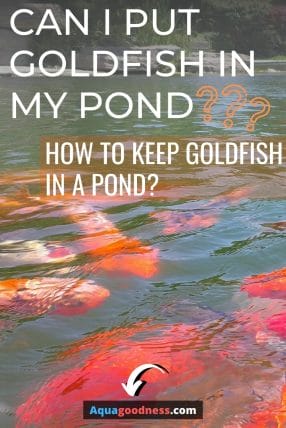
Keeping goldfish in your pond will give your pond a very beautiful look. And it is very easy to keep goldfish in a pond.
However, you’ll need to create an ideal environment for your goldfish in your pond for their proper growth and development.
In this article, I’m going to tell you how you can create the ideal environment for goldfish in your pond.
Keep reading…
Table of Contents
Which goldfish can live in a pond?
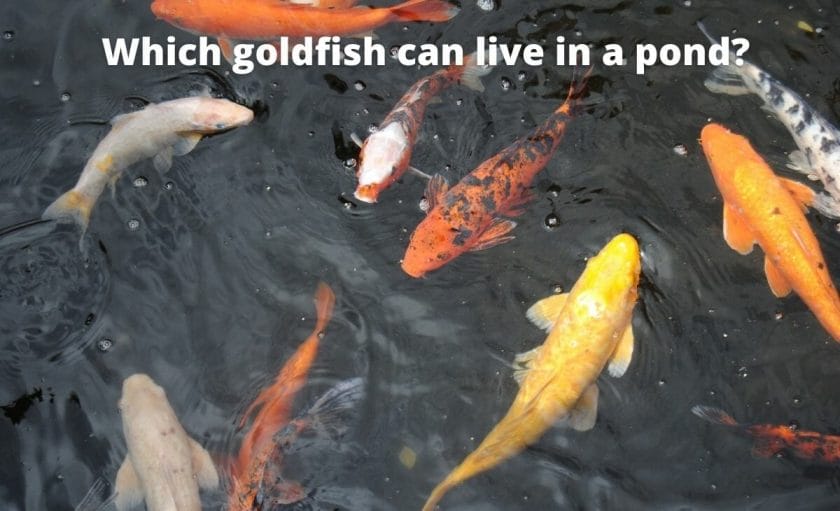
There’re different varieties of goldfish you can keep in your pond.
1. Shubunkin goldfish
Shubunkin is the most colorful species of goldfish. This goldfish posses white, black, blue, red, oranges patches throughout its body.
The thing that makes shubunkin unique from other varieties of goldfish is that it has blue coloration on its body. And this determines its cost. The more blue color a goldfish has the rarer it is and the more expensive it will be.
2. Sarasa Comet
Sarasa Comet is one of the easiest goldfish to keep in a pond.
This goldfish is very hardy.
It is not a picky eater. And it’s a very low maintenance fish that’s why it is recommended for beginners.
It features intense red coloration on its white body.
However, a younger Sarasa comet goldfish does not develop color until the age of 8 months old.
It looks similar to Kohaku Koi that’s why sometimes people get confused between the two.
3. Comet goldfish
Comet goldfish are the most common goldfish to keep in a pond.
This variety of goldfish is very hardy so it can survive harsh weather.
Comet goldfish features red, orange, or lemon-yellow color throughout its body. Besides these colors, comet goldfish can also have other colors.
Comet goldfish have long slender bodies which allow them to cut through the water and swim fast. That’s why it is not recommended to keep them together with fancy varieties of goldfish.
Fancy varieties of goldfish usually have bulkier bodies and they cannot swim as fast as comet goldfish. This can starve fancy goldfish in a pond. And it can also cause tress to fancy goldfish during the breeding season.
4. Wakin goldfish
Wakin is a very popular variety of Common goldfish. It features intense red and white coloration.
Wakin goldfish can have a single, twin, or triple tail. A wakin goldfish with a triple butterfly tail is the rarest.
These goldfish as slender bodies so they can move pretty fast. Also, they’re very active fish.
5. Fantail goldfish
Fantail goldfish is the hardiest of the fancy varieties of goldfish. This is the reason they’re recommended to beginners.
As the name suggests, the fantail goldfish is known for its tail that resembles to fan.
The tail of a fantail goldfish is divided into two halves.
It also features shining scales throughout its body.
Fantail goldfish come in either red, orange, and yellow colors.
Fantail goldfish are very pleasant to look at as they swim around with their long tail and shiny scales.
If you take aa good care of fantail goldfish they can live for 20 years in the pond!
Can I put goldfish in my indoor pond?
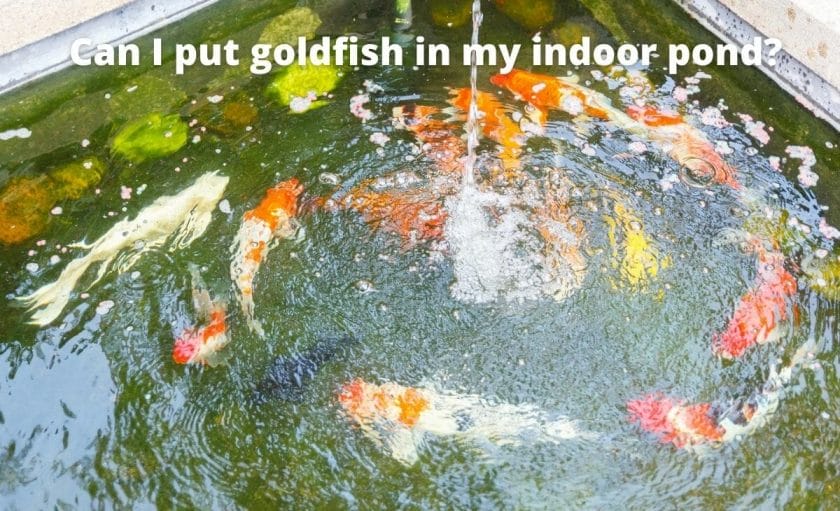
You can put goldfish in your indoor pond. Keeping goldfish in an indoor plant is actually a very good thing for goldfish because an indoor pond is most likely going to provide more space for goldfish than an aquarium tank.
As goldfish can grow very large, they’ll appreciate the more space that an indoor pond can provide.
How to keep goldfish in an indoor pond?
Goldfish can grow very large that’s why they need a lot of space to swim around. So if you want to keep goldfish in your indoor pond, make sure that is big enough for the goldfish.
You can put goldfish in your indoor pond. Just make sure the pond is big enough for the goldfish.
A single goldfish need at least a 40-gallon. And 10 gallons more for every additional goldfish.
Also, make sure to cycle your pond before adding the goldfish to the pond.
Cycling is basically a process of hosing beneficial bacteria in your pond.
The beneficial bacteria are necessary to break down ammonia produced by fish waste and convert it into less harmful nitrate.
You can know more about cycling here.
Also, here’re some ways to cycle instantly. This blog post is originally written for cycling a fish tank. But you can use the same methods to cycle your pond.
Before adding the goldfish to the pond, you’ll need to set up a good filtration in your pond.
In an indoor pond, you can use a pond filter like this filter from VIVOHOME (link to Amazon). It comes with a fountainhead which will help to keep your pond well-oxygenated.
You’ll need to add an air pump in the indoor pond to keep the pond well oxygenated.
You can use an aquarium bubbler with light (link to Amazon). These bubblers will not only oxygenate your pond but also light it up!
If you live in a colder region then you may also need to add a heater in the pond to maintain the temperature of the water of the pond within the ideal range.
Can I put goldfish in an outdoor pond?
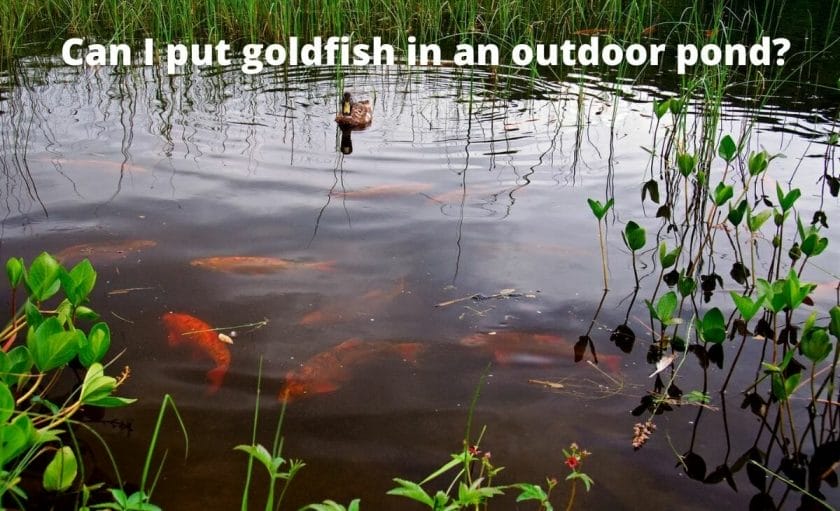
You can put goldfish in your outdoor pond. Keeping goldfish in an outdoor pond will provide them with a lot of space to swim around.
Also, in your outdoor pond, you can emulate their natural habitat which will definitely help with the proper growth and development of goldfish.
How to keep goldfish in an outdoor pond?
Goldfish are very hardy fish and they don’t need a lot of care.
However, you’ll need to create an ideal environment for them in your pond to keep them happy and healthy.
Pond size
Goldfish can grow pretty large. A goldfish can grow as large as 14 inches!
As goldfish can grow pretty large they need a lot of space to swim around.
A single goldfish need about 40 gallons of water. And 10 more gallons for every additional goldfish.
When it comes to pond size for goldfish, generally, the larger the pond the better.
A pond can’t be too large for goldfish!
But keeping a lot of goldfish in a relatively smaller pond can affect their health.
Another benefit of having a larger pond is that, in a larger pond, the water chemistry and temperature don’t change quickly. As it can happen in a smaller pond.
This is important because when the water chemistry or temperature of the water in the pond changes quickly it stresses the fish which can lead to diseases.
Pond location
Your pond should be located where it can get good sunlight and shade throughout the day.
If your pond gets a lot of sunlight then you can easily create some shaded area in your pond by adding some aquatic plants in your pond.
Floating aquatic plants such as Waterlilies, Lotus, Water lettuce are great to create hiding places in a pond.
Ideally, around 30%-50% of your pond should have vegetation.
Vegetation will provide a lot of hiding places for the goldfish. It will also help to maintain good water quality by absorbing nitrates from the water.
Plants will also help to keep the pond well oxygenated by taking carbon dioxide and releasing oxygen during the day.
Another important thing to keep in mind when it comes to the location of your pond is that there should not be deciduous trees hanging above the pond.
This is important because the leaves falling off from the deciduous trees will eventually break down and produce a lot of ammonia in the pond.
As ammonia is deadly for the fish that’s why there should not be any deciduous trees hanging above your pond.
Filtration
Filtration is very important to maintain healthy water quality in your pond.
A filter not only clears the visible debris from the pond but also provides a place where the nitrifying bacteria form their colonies.
Nitrifying bacteria commonly known as beneficial bacteria are the bacteria that convert deadly ammonia produced by fish waste into less harmful nitrates.
How to choose the best filter for your pond?
There are a few things that come into play while deciding the best filter for your pond.
Size of your pond
Depending on the size of your pond you’ll need to choose a filter that can pump in and out water in your pond.
For example, if you have a large pond then you’ll need a filter that can pump a lot of water in and out of the pond compared to if you have a smaller pond.
Fish stock in your pond
The bioload built in your pond will depend on the number of fish you keep in a pond.
So if you have a lot of fish in your pond then they will produce a lot of bioload in the pond. To handle the bioload, you’ll need a larger filter in your pond.
Depth of the pond
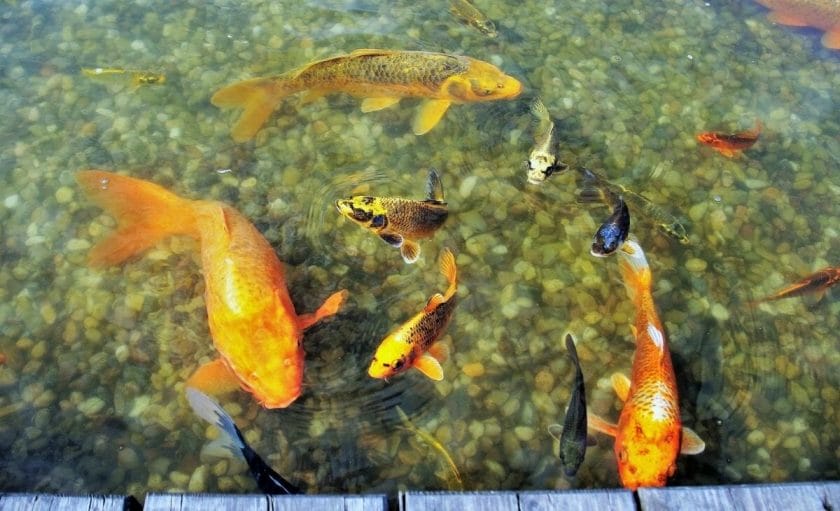
This factor is generally overlooked when it comes to choosing a filter for the pond.
You’ll need more filtration for a shallow pond than a deeper pond.
A pond with less than 29 inches is considered a shallow pond.
So how to choose a filter for your pond?
A good general rule of thumb to follow while deciding the best filter for your pond is to choose a filter that can pump double the amount of water that your pond has.
For example, if your pond size is 1000 gallons then you should have a filter that can pump 2000 gallons of water per hour.
When it comes to filtration for a pond, the more the filtration the better.
You can’t have too much filtration!
Oxygen
Goldfish need a lot of oxygen in a pond.
The beneficial bacteria also need oxygen to survive and grow in a pond.
You can easily keep your pond well oxygenated using a filter, air pump, fountain, waterfall, etc.
Basically, you need water agitation on the surface of the water of your fish pond to keep it well oxygenated.
Besides, live aquatic plants also release oxygen during the day.
However, live aquatic plants release carbon dioxide during the night. That’s why you’ll need to have a system in place to keep your pond well oxygenated during the night.
Besides, you’ll need more water agitation during the summer season. This is because, during summer, the water in your pond gets warm and warmer water cannot hold as much oxygen as cooler water can.
Again, using a filter, installing an air pump (link to Amazon), fountain and waterfall can help to keep your pond well oxygenated during the night and summer season.
Conclusion
You can keep goldfish in your indoor and outdoor pond.
As goldfish can grow very large, keeping them in a pond will provide them adequate space to swim around.
Make sure to create and maintain the ideal environment for your goldfish in your pond for their proper growth and development.
The information in this article will help you create the ideal environment for the goldfish in your pond.
Let me know if you have any questions regarding the topic in the comments down below.
Also, feel free to share more information regarding the topic in the comments.
If you found the article helpful, please share it!
Happy fishkeeping!